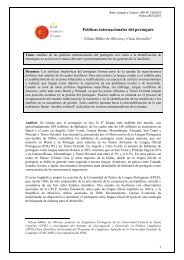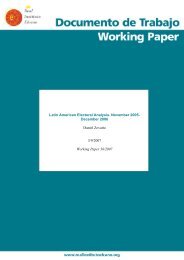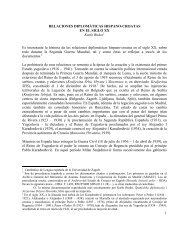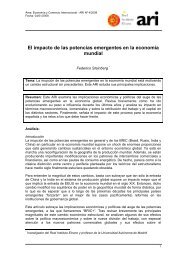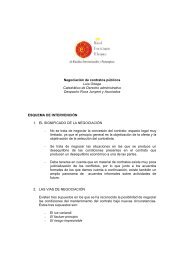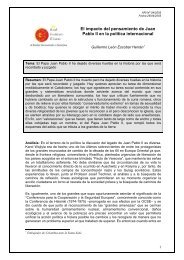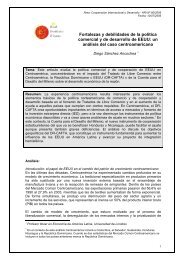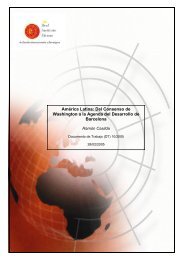Spain and the United States - Real Instituto Elcano
Spain and the United States - Real Instituto Elcano
Spain and the United States - Real Instituto Elcano
Create successful ePaper yourself
Turn your PDF publications into a flip-book with our unique Google optimized e-Paper software.
130<br />
SPAIN AND THE UNITED STATES<br />
Exhibit 7.6 Labour Productivity per Person Employed (EU-25 = 100)<br />
quality. Multinationals are impressed by <strong>the</strong> quality of <strong>Spain</strong>’s executives but<br />
increasingly worried by <strong>the</strong> gap that is opening up between <strong>the</strong>ir skills <strong>and</strong><br />
those of workers on <strong>the</strong> shop floor. <strong>Spain</strong> is at <strong>the</strong> bottom of developed<br />
countries in terms of <strong>the</strong> educational results of its students: 33% do not<br />
complete <strong>the</strong>ir upper secondary education compared with an average of 21% in<br />
all OECD countries.<br />
What is of particular concern for <strong>the</strong> future of <strong>Spain</strong> is that countries with<br />
a lower per student level of expenditure, such as Hungary <strong>and</strong> Pol<strong>and</strong>, have<br />
better educated workforces. <strong>Spain</strong>’s high-tech exports account for only 11% of<br />
its total exports of manufactured goods, compared with 30% in Hungary (see<br />
Exhibit 7.5). Ano<strong>the</strong>r indicator of <strong>Spain</strong>’s low level of innovation is its number<br />
of patents per million inhabitants, which in 2001 (latest year available) was 18,<br />
compared with an EU-25 average of 109 <strong>and</strong> <strong>the</strong> US’s 95.<br />
The combination of higher wage increases in <strong>Spain</strong> – <strong>the</strong> result of a<br />
persistent inflation differential with <strong>the</strong> EU-25 (a full percentage point in 2004)<br />
<strong>and</strong> wage-setting <strong>and</strong> indexing mechanisms that set a higher floor for nominal<br />
wage growth than in o<strong>the</strong>r countries <strong>and</strong> very low productivity gains – is<br />
eroding competitiveness. The modest labour productivity reflects, among o<strong>the</strong>r<br />
factors, very strong job creation, which is something very positive <strong>and</strong> has<br />
been <strong>the</strong> driving force behind <strong>Spain</strong>’s exceptionally long period of economic<br />
expansion. This period has lasted much longer than most people envisaged <strong>and</strong><br />
has substantially reduced <strong>the</strong> high unemployment rate to below 10%, almost in<br />
line with <strong>the</strong> EU-25 average (see Exhibit 7.6). Employment increased by 2.7%<br />
in 2004 <strong>and</strong> apparent labour productivity was only 0.4%. <strong>Spain</strong>’s productivity<br />
per hour worked dropped from 82.2% of <strong>the</strong> US level in 1991 to 75.3% in<br />
2003, according to <strong>the</strong> Bank of <strong>Spain</strong>. 6<br />
6. See <strong>the</strong> table on p. 24 of <strong>the</strong> Bank of <strong>Spain</strong>’s 2004 Annual Report.



